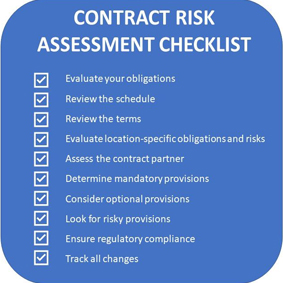the organization faces risky contract clauses. How will you navigate this challenging situation?
Navigating risky contract clauses is a critical challenge for organizations, as contracts often contain conditions that can expose them to financial, legal, and operational risks. To effectively manage these risks, organizations need to engage in proactive contract risk management, which includes identifying risks, understanding potential vulnerabilities, and applying best practices throughout the contract lifecycle. Below are strategies and recommendations to navigate this situation effectively.
Understanding Contract Risks
-
Types of Contract Risks:
- Financial Risk: Potential for loss due to missed payments or contract failure leading to financial instability.
- Legal Risk: Risks arising from non-compliance with laws and regulations, potentially resulting in litigation or fines.
- Operational Risk: Issues that affect the organization’s ability to perform contractual obligations, often due to mismanagement or insufficient resources.
- Reputational Risk: Possible damage to the organization’s reputation due to unethical contract terms or failures.
- Security Risk: Exposure to data breaches or loss of intellectual property due to inadequate contractual protections.
-
Identifying Contract Risks:
- Evaluate financial commitments, compliance requirements, and operational capabilities.
- Conduct regular risk assessments and audits to pinpoint high-risk contracts and ensure transparency.
Best Practices for Navigating Contract Risks
1- Drafting and Negotiating Effective Contracts:
- Use clear and concise language to ensure all parties understand obligations and expectations.
- Incorporate specific terms for performance expectations, including penalties for non-compliance.
- Utilize limitation of liability clauses to cap potential damages in case of breaches.
2- Implement Strong Contract Management Systems:
- Centralize contract storage and use management software to improve accessibility and monitoring of contract obligations and deadlines.
- Enhance visibility through cloud-based systems that allow for searchability and tracking of key conditions.
-
Regular Monitoring and Reviews:
- Establish procedures for monitoring contract performance against key performance indicators (KPIs) and conducting regular reviews to ensure compliance with terms.
- Set up automated reminders for key dates, such as renewal deadlines, to prevent oversight.
-
Enhancing Collaboration and Communication:
- Foster open lines of communication among all stakeholders involved in contract management, including legal, finance, and operational teams.
- Arrange regular meetings to discuss contract performance and any emerging issues to facilitate proactive management.
-
Training and Awareness:
- Provide ongoing training for employees on contract terms, risk management practices, and compliance requirements to ensure they understand the implications of contract risks.
Conclusion
Successfully navigating risky contract clauses requires a comprehensive approach that combines effective drafting, diligent management, regular monitoring, and collaboration across departments. Organizations can mitigate risks and safeguard their interests by adopting best practices and utilizing contract management software, minimizing the likelihood of costly disputes or breaches. A proactive contract risk management strategy not only protects the business but can also enhance operational efficiency and foster stronger relationships with partners and stakeholders.





